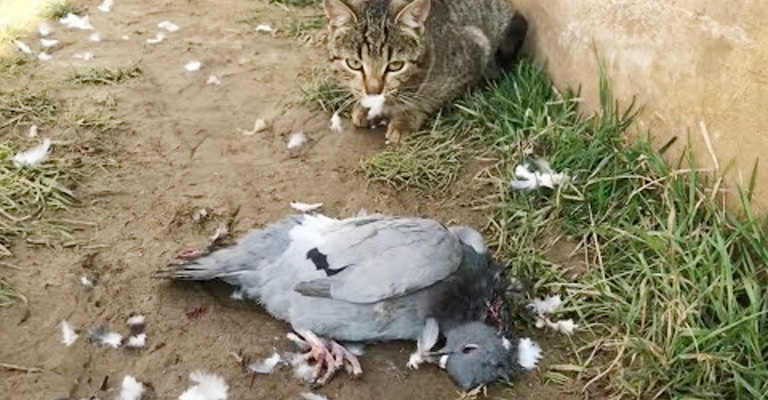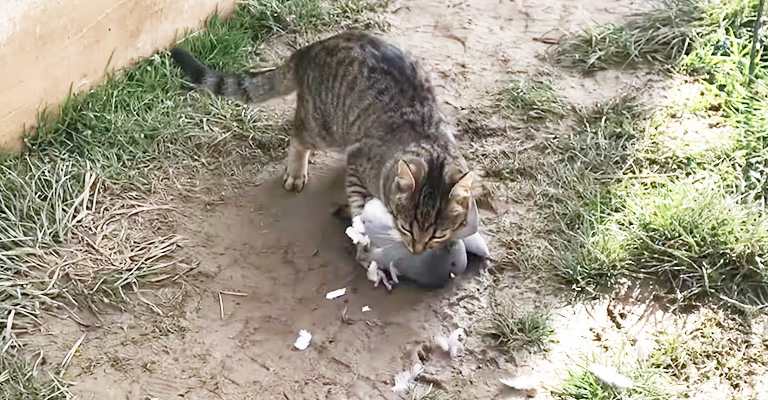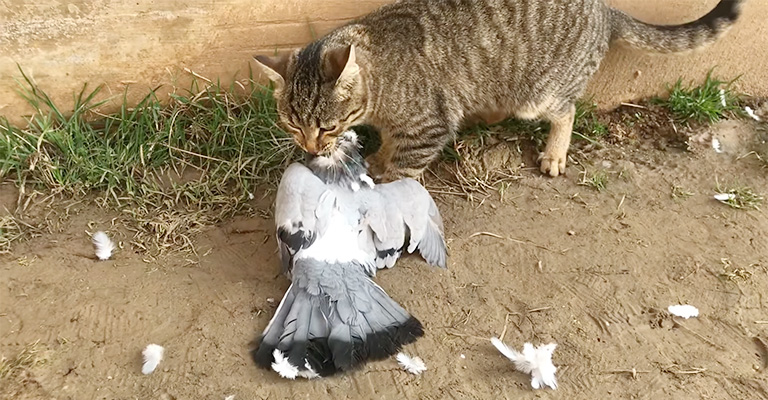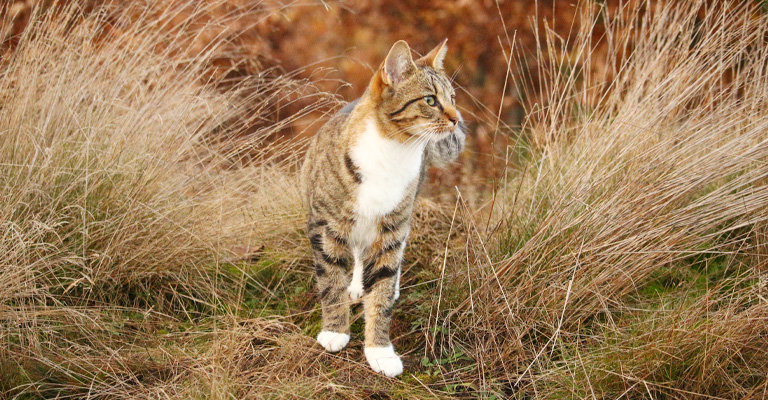As the Canadian landscape transforms with each passing season, it plays host to a remarkable variety of avian species. From the majestic bald eagle to the delicate warbler, Canada’s skies are alive with the vibrant colors and songs of birds.
Yet, amidst this natural symphony, a silent predator prowls – the domestic cat. In this exploration, we embark on a journey to uncover the enigmatic question: How many birds do cats kill in Canada, and why?
Canada’s diverse ecosystems provide a home to countless bird species, each playing a unique role in maintaining the balance of nature.
However, the presence of domestic cats, cherished companions to many, poses an ecological challenge. Understanding the extent of this challenge and the underlying factors that drive it is essential for wildlife conservation.
Join us as we unravel the complex relationship between cats and birds in the sprawling landscapes of Canada.

How Many Birds Do Cats Kill in Canada and Why?
The exact number of birds killed by cats in Canada is challenging to quantify precisely due to various factors and limitations in data collection.
However, studies and estimates suggest that domestic and feral cats collectively kill millions of birds each year in Canada. Some sources have revealed that cats kill about 100 million birds each year in Canada. Several reasons contribute to this issue:
Hunting Instinct
Cats are natural predators, and their hunting instincts drive them to pursue birds and other small animals, even when well-fed.
Outdoor Access
Cats with outdoor access have more opportunities to hunt birds. In Canada, where many households allow cats outdoors, this can lead to increased bird predation.
Bird Vulnerability
Many bird species in Canada are not well-adapted to defend against introduced predators like cats, making them particularly vulnerable.
Seasonal Variation
Bird predation can vary seasonally, with higher rates during the nesting and fledgling stages when birds are more accessible.
Feral Cat Populations
Feral cats, which are present in various parts of Canada, are prolific hunters and have a significant impact on native bird populations.
Urbanization and Habitat Loss
As urban areas expand, natural bird habitats are often replaced by buildings and roads. Cats in urban and suburban settings may encounter birds more frequently as a result.
Bird Nesting Sites
Cats are more likely to prey on birds during nesting seasons when parent birds are actively caring for their chicks. Nesting birds may be particularly vulnerable to cat predation.
Nocturnal Predation
Cats are crepuscular and nocturnal hunters, which means they are most active during dawn and dusk, times when many bird species are also active. This increases the likelihood of cat-bird interactions.
Climate and Migration
Canada’s diverse climate zones attract a wide variety of migratory birds. Cats may pose a threat to these birds during their migration, as they pass through areas where cats are present.
Impact on Ecosystems
Beyond direct bird predation, cats can indirectly affect bird populations by disrupting ecosystems. For instance, when cats prey on small mammals that serve as seed dispersers, it can impact plant regeneration and subsequently affect bird habitats.
Lack of Natural Predators
Domestic cats have few natural predators in Canada, allowing their populations to thrive and exacerbating their impact on bird populations.
Efforts to address this issue include responsible pet ownership practices (e.g., keeping cats indoors or in enclosed outdoor spaces), public awareness campaigns, conservation initiatives.
These efforts help us to protect critical bird habitats and research to better understand and address the complex interplay between cats and birds in Canada’s diverse ecosystems.
Do Domestic Cats Kill Birds in Canada?

Yes, domestic cats in Canada are known to kill birds. Cats are natural predators with hunting instincts, and when they have outdoor access, they may hunt birds and other small animals.
The extent to which domestic cats kill birds in Canada can vary depending on factors such as the cat’s hunting behavior, the local environment, and the availability of prey.
While not all domestic cats actively hunt birds, many do, and their hunting activities can have a notable impact on local bird populations.
To mitigate this impact and protect native wildlife, responsible pet ownership practices, such as keeping cats indoors or providing outdoor enclosures, are recommended.
These measures help reduce the risk to birds and other wildlife while allowing cats to enjoy a safe and enriched environment.
How Do You Stop Cats from Killing Birds?

To prevent cats from killing birds and reduce their impact on local bird populations, you can take several proactive steps as a cat owner or as part of a community effort. Here are some effective strategies:
Keep Cats Indoors
One of the most effective ways to prevent cats from hunting birds is to keep them indoors at all times. Indoor cats are not exposed to potential prey, minimizing their impact on local wildlife.
Use Outdoor Enclosures
If you want your cat to enjoy the outdoors safely, consider installing an outdoor enclosure or “catio.” These enclosed spaces provide cats with fresh air and the sights and sounds of nature without allowing them to hunt.
Supervise Outdoor Time
If you prefer to let your cat outside, supervise their outdoor activities. Use a leash and harness to walk your cat, ensuring they don’t have the opportunity to hunt birds.
Bells or Collars with Bells
Attach a collar with a bell to your cat. While not foolproof, bells can sometimes alert birds to the cat’s presence, giving them a chance to escape.
Spaying/Neutering
Spaying or neutering your cat can reduce their hunting instincts and roaming behavior, which, in turn, can decrease their impact on wildlife.
Feed Cats Adequately
Ensure your cat is well-fed with balanced meals. A well-fed cat is less likely to hunt for food.
Provide Toys and Enrichment
Cats have a natural instinct to hunt and play. Provide toys and engage your cat in interactive play to satisfy their hunting instincts indoors.
Educate Others
Spread awareness about the impact of outdoor cats on bird populations. Encourage responsible pet ownership practices among fellow cat owners.
Support TNR Programs
If you come across feral or stray cats in your community, support Trap-Neuter-Return (TNR) programs to control their populations in a humane way.
Collaborate with Local Authorities
Work with local animal control or environmental agencies to address feral cat populations and implement community strategies for bird conservation.
By implementing these measures, you can help protect both your cat and local bird populations, fostering a safer coexistence between domestic cats and wildlife.
What Measures Has the Canadian Government Taken?

The Canadian government has not implemented nationwide policies specifically targeting the issue of domestic cats killing birds.
However, the government does have broader environmental and wildlife protection measures in place that indirectly affect this issue. Here are some of the actions and initiatives the Canadian government has taken:
Wildlife Conservation Laws
Canada has various federal and provincial/territorial wildlife conservation laws and regulations aimed at protecting native species and their habitats. These laws help safeguard bird populations, including those at risk from cat predation.
Protected Areas
The Canadian government has established numerous national and provincial parks and protected areas that provide habitats for native bird species. These areas indirectly protect birds from cat predation by limiting human and pet access.
Research Funding
Government agencies often provide funding for research related to wildlife conservation and ecosystem management, which can include studies on the impact of predators like cats on bird populations.
Public Awareness Campaigns
The government, alongside environmental organizations, has occasionally supported public awareness campaigns about responsible pet ownership, which may include information on the impact of cats on wildlife.
Collaboration
Federal, provincial, and territorial governments work with wildlife conservation organizations and community groups to develop and implement strategies for the protection of native species, including birds.
If you’re interested in the most current information on Canadian government actions related to cats and their impact on wildlife, I recommend checking with relevant government agencies or environmental organizations for updates and initiatives specific to your region.
FAQs
The exact number of birds killed by domestic cats in Canada annually is challenging to determine precisely due to various factors and limitations in data collection.
However, estimates suggest that millions of native birds are killed by domestic cats each year.
Outdoor cats pose a greater threat to bird populations in Canada because they have more opportunities to encounter and hunt birds. Indoor cats are generally less likely to hunt birds.
To protect migrating birds from cat predation, it’s essential to keep cats indoors during migration seasons when birds are passing through. This can significantly reduce the risk of encounters between cats and migrating birds.
The impact of cats on bird populations can vary across regions in Canada. Areas with high concentrations of vulnerable or endangered bird species, as well as regions with extensive urbanization and habitat loss, may experience more severe cat-related bird predation.
If you come across feral or stray cats in your community, consider supporting Trap-Neuter-Return (TNR) programs or contacting local animal control or rescue organizations. These programs help control feral cat populations.
Conclusion
The impact of domestic cats on Canadian bird populations is a multifaceted issue that warrants attention and action.
While it is challenging to pinpoint the exact number of birds killed by cats, research and observations indicate that these beloved pets are contributing to declines in native bird species across Canada.
Several factors contribute to this issue, including cats’ inherent hunting instincts, outdoor access, and the vulnerability of birds during nesting and fledgling stages.
These challenges are compounded by the vast and varied Canadian landscape, which hosts a wide array of bird species, each with its own ecological significance.
Conservation measures, such as responsible pet ownership, the promotion of indoor cats, and awareness campaigns, are essential steps in mitigating the impact of cats on Canadian birds.
Together, we can ensure that both cats and birds can thrive harmoniously in the diverse Canadian habitats they call home.